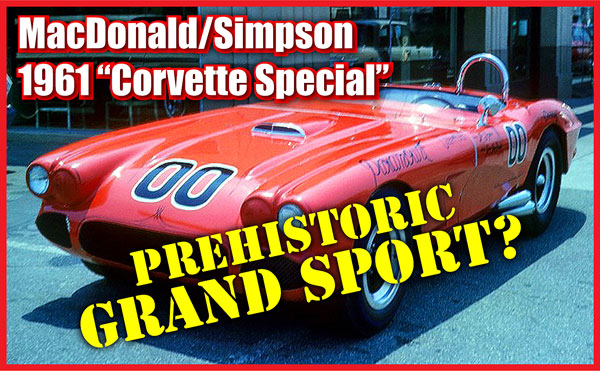What ever became of the first, independent, purpose-built, 1,750-pound Corvette racer?
Unless you are familiar with the early days of Corvette racing, the name Dave MacDonald might not be familiar to you. But 60 years ago, the Corvette and racing community was closely watching MacDonald. Many said that Dave had the potential to be one of the “great” American road racing drivers. Nicknamed the “Master of Oversteer” MacDonald’s tail-out driving style thrilled crowds and chilled competitors.
Meet Dave MacDonald, the Master of Oversteer
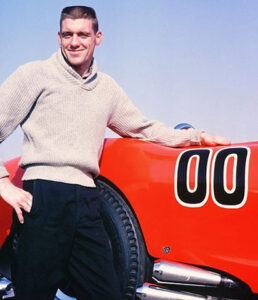 MacDonald was the classic American hero; Hollywood good looks, a family man, a gentleman, understated, humble, yet a hard-charging competitor on the race track. He loved America’s sports car but could take almost any kind of race car to the winner’s circle. MacDonald had the admiration and respect of his peers, as well as support from powerful men in racing.
MacDonald was the classic American hero; Hollywood good looks, a family man, a gentleman, understated, humble, yet a hard-charging competitor on the race track. He loved America’s sports car but could take almost any kind of race car to the winner’s circle. MacDonald had the admiration and respect of his peers, as well as support from powerful men in racing.
Fate had other ideas, though. When the future seemed golden for MacDonald, circumstances found him in the wrong place on the track at the 1964 Indy 500. MacDonald, along with Eddie Sachs, were tragically killed when the car MacDonald was driving, Mickey Thompson’s “Sears-Allstate Special” went out of control on the second lap of the race. The post-race investigation determined that there was “no driver error.” All too soon, a brilliant career came to an end.
Dave MacDonald came of age in the perfect place and time for young car guys – early ‘50s southern California. Think “American Graffiti” and you’re getting warm. Dave’s first ride was an early ‘50s Cadillac. Don’t laugh, those old Caddys had some of the most powerful engines of their day. But it was a 265 V8 ‘55 Corvette that made MacDonald a Corvette man. The lightweight, high revving small-block Chevy engine was perfect for the Corvette. Drag racing was the everyman’s motorsport and MacDonald honed his horsepower handling skills with Corvettes, one quarter of a mile at a time.
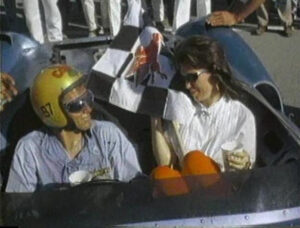 Like many young men of his day, Dave married his sweetheart. MacDonald first saw Sherry Gravett when she was in the lead of her high school play. The pair talked on the phone for two months before she finally met her future husband. Two months after Sherry graduated, the couple were married and started their life together. Dave had a good job at the local Chevy dealer and was able to afford a new Corvette every few years. Dave was still into drag racing, but Corvettes have that “handling thing” that inspires many to go around corners, FAST. But, that’s what Corvettes are designed to do.
Like many young men of his day, Dave married his sweetheart. MacDonald first saw Sherry Gravett when she was in the lead of her high school play. The pair talked on the phone for two months before she finally met her future husband. Two months after Sherry graduated, the couple were married and started their life together. Dave had a good job at the local Chevy dealer and was able to afford a new Corvette every few years. Dave was still into drag racing, but Corvettes have that “handling thing” that inspires many to go around corners, FAST. But, that’s what Corvettes are designed to do.
Meet the MacDonald/Simpson Racing Team
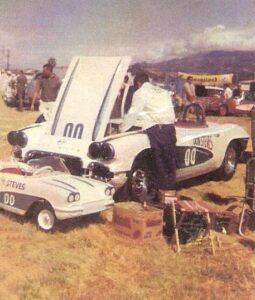 MacDonald struck up a friendship with car salesman Jim Simpson, who soon became MacDonald’s racing partner/sponsor. At Willow Springs in February 1960, MacDonald began his professional racing career. In the first year, the team entered 15 races, finished 1st place three times, 2nd place three times, and 3rd place four times. In his first year, Dave never finished lower than 4th place. 1961 proved to be MacDonald’s breakout year. In 20 events, Dave took 1st place 13 times and 2nd place three times. MacDonald won the first seven races of the season and went on to dominate the season.
MacDonald struck up a friendship with car salesman Jim Simpson, who soon became MacDonald’s racing partner/sponsor. At Willow Springs in February 1960, MacDonald began his professional racing career. In the first year, the team entered 15 races, finished 1st place three times, 2nd place three times, and 3rd place four times. In his first year, Dave never finished lower than 4th place. 1961 proved to be MacDonald’s breakout year. In 20 events, Dave took 1st place 13 times and 2nd place three times. MacDonald won the first seven races of the season and went on to dominate the season.
You just can’t win races like that and not get noticed. While Carroll Shelby had retired as a driver, he was in the thick of things getting his Cobra deal together. According to Dave MacDonald’s son, Rich, it was Shelby who first suggested that Dave should consider a purpose-built car. No one knows if it was just an offhanded comment from Shelby, but the seed was planted.
Purpose-built, tube-framed race cars were nothing “new” in 1961. All serious race cars were tube-framed lightweights. Mercedes-Benz was arguably the leader in this type of construction and had many imitators. Even Duntov used the birdcage frame from a Mercedes 300 SL as his template for the 1957 Corvette SS racer.
One of the two frames Duntov built was later used under Bill Mitchell’s 1959 Stingray Racer and won the 1959 SCCA B/Production Championship. “Tube framed” race cars were the way to go and it just so happened that there was a local legend that built tube frame cars. Enter Max Balchowsky.
Max and Ida Balchowsky Build the Boys a Real Racecar
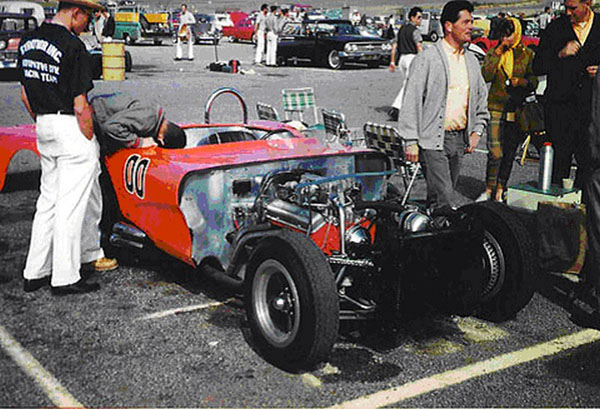 Max and Ida Balchowsky had made quite a name for themselves with their “Old Yeller” racers. Shelby drove Balchowsky’s Old Yeller II in ‘58 and Dan Gurney drove the car in ‘60. So it wasn’t much of a stretch for Shelby to say to MacDonald, “You should get a Balchowsky chassis.” MacDonald and Simpson took Carroll’s advice, and Simpson paid $4,500 for a Balchowsky chassis and running gear (approximately $46,000 in 2022 dollars) – a considerable sum, as a new ‘61 Corvette cost $3,934.
Max and Ida Balchowsky had made quite a name for themselves with their “Old Yeller” racers. Shelby drove Balchowsky’s Old Yeller II in ‘58 and Dan Gurney drove the car in ‘60. So it wasn’t much of a stretch for Shelby to say to MacDonald, “You should get a Balchowsky chassis.” MacDonald and Simpson took Carroll’s advice, and Simpson paid $4,500 for a Balchowsky chassis and running gear (approximately $46,000 in 2022 dollars) – a considerable sum, as a new ‘61 Corvette cost $3,934.
Here’s how the car came together.
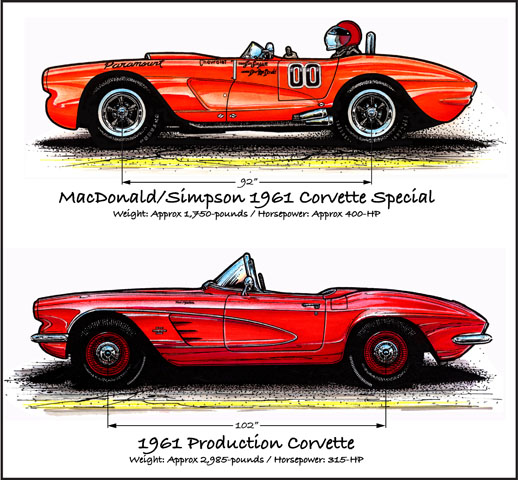 While Corvettes look small today, back in the ‘50s and ‘60s, they were huge compared to other sports cars. Max and Ida built the chassis and MacDonald and Simpson made the Corvette body to fit. There were no companies making fiberglass replica bodies in those days, so Simpson “borrowed for the weekend” a new ‘61 Corvette from Sorenson Chevrolet to make molds to make a Corvette-like body.
While Corvettes look small today, back in the ‘50s and ‘60s, they were huge compared to other sports cars. Max and Ida built the chassis and MacDonald and Simpson made the Corvette body to fit. There were no companies making fiberglass replica bodies in those days, so Simpson “borrowed for the weekend” a new ‘61 Corvette from Sorenson Chevrolet to make molds to make a Corvette-like body.
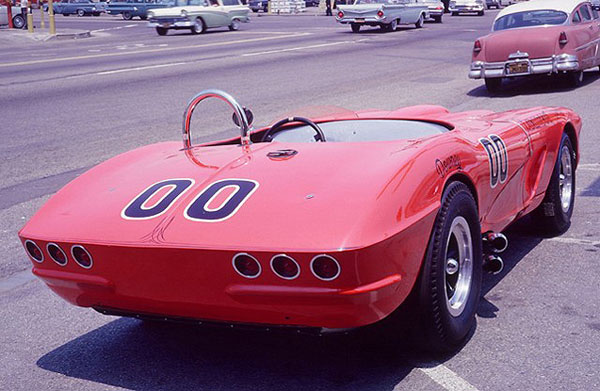 The body was built at Nat Redder’s fiberglass shop on Hollywood Blvd., one of the earliest Corvette fiberglass shops. They created an 85-pound, 7/8s scale ‘61 Corvette body that was reduced in length by 18 inches, by 5 inches in width, 4 inches in height, and the wheelbase by 10 inches. With a custom-made chassis, body, and slightly modified 327/360 HP Fuel Injected Corvette engine, with a T-10 all-aluminum 4-speed trans, MacDonald, Simpson, and some friends completed the Corvette Special in just 2-1/2 months over the Summer of ‘61.
The body was built at Nat Redder’s fiberglass shop on Hollywood Blvd., one of the earliest Corvette fiberglass shops. They created an 85-pound, 7/8s scale ‘61 Corvette body that was reduced in length by 18 inches, by 5 inches in width, 4 inches in height, and the wheelbase by 10 inches. With a custom-made chassis, body, and slightly modified 327/360 HP Fuel Injected Corvette engine, with a T-10 all-aluminum 4-speed trans, MacDonald, Simpson, and some friends completed the Corvette Special in just 2-1/2 months over the Summer of ‘61.
Zora Arkus-Duntov Pays MacDonald a Visit
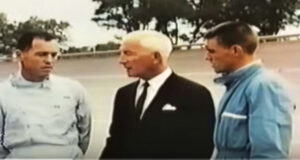 It was during this time that MacDonald had an unexpected visit from Zora Arkus-Duntov. A passionate racer since the ’30s, Duntov closely followed racing and was well aware of Dave MacDonald. One day in the summer of ‘61 while in Los Angeles on business, Duntov spent the afternoon at MacDonald’s house talking racing and the Corvette Special.
It was during this time that MacDonald had an unexpected visit from Zora Arkus-Duntov. A passionate racer since the ’30s, Duntov closely followed racing and was well aware of Dave MacDonald. One day in the summer of ‘61 while in Los Angeles on business, Duntov spent the afternoon at MacDonald’s house talking racing and the Corvette Special.
MacDonald’s younger brother, Doug was just a young teenager but remembers Duntov’s visit. “I did my best to hang around but stay out of the way, so I can’t say that I was in on the conversation. I was off to the sides, trying to understand Mr. Duntov’s thick accent.” relates Doug MacDonald. “I was hardly able to understand Mr. Duntov, and Dave spoke softly, so I wasn’t catching very much.”
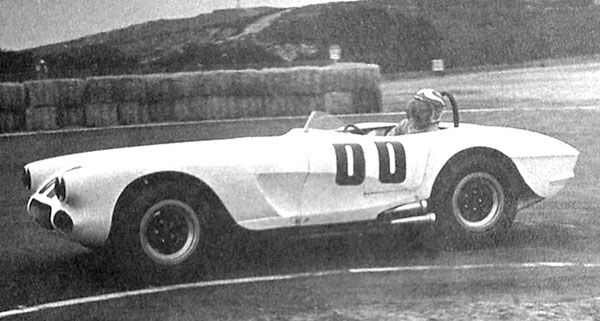 The Corvette Special had its shakedown race at Laguna Seca on October 22, 1961, and was a DNF. Nothing serious, just the usual “new car bugs” stuff. Balchowsky liked to set up the suspension of his Old Yeller cars “loose” whereas MacDonald liked his cars tight. While MacDonald wasn’t shy about letting it all hang out on the track, the Balchowsky setup was described as “unnerving” for Dave.
The Corvette Special had its shakedown race at Laguna Seca on October 22, 1961, and was a DNF. Nothing serious, just the usual “new car bugs” stuff. Balchowsky liked to set up the suspension of his Old Yeller cars “loose” whereas MacDonald liked his cars tight. While MacDonald wasn’t shy about letting it all hang out on the track, the Balchowsky setup was described as “unnerving” for Dave.
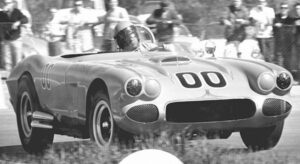 By the second race on November 11, 1961, the car was pretty much dialed in and MacDonald took 2nd place. Four weeks later, after more adjusting, the Corvette Special took another 2nd place win and a 1st place win. This was the Special’s first big win, and unfortunately, the beginning of not very many races for the ’61 Corvette Special.
By the second race on November 11, 1961, the car was pretty much dialed in and MacDonald took 2nd place. Four weeks later, after more adjusting, the Corvette Special took another 2nd place win and a 1st place win. This was the Special’s first big win, and unfortunately, the beginning of not very many races for the ’61 Corvette Special.
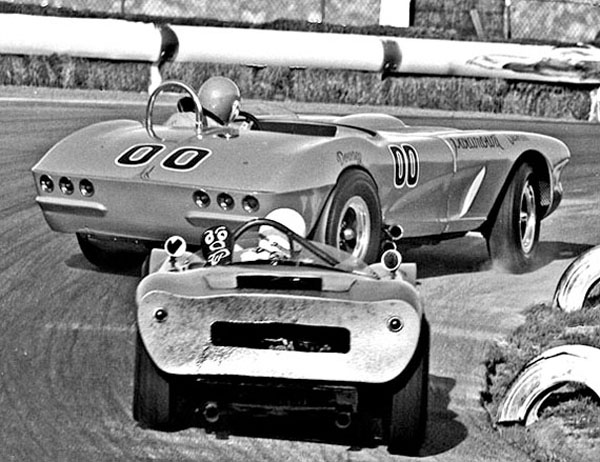 For the 1962 season, the MacDonald/Simpson Corvette Special took 1st place in the first 3 races of the season. But Dave and Jim determined that they stood a better chance of a championship if they raced the production-based Corvette. So the Special was parked and they raced the production Corvette to the B/Production championship in 1962.
For the 1962 season, the MacDonald/Simpson Corvette Special took 1st place in the first 3 races of the season. But Dave and Jim determined that they stood a better chance of a championship if they raced the production-based Corvette. So the Special was parked and they raced the production Corvette to the B/Production championship in 1962.
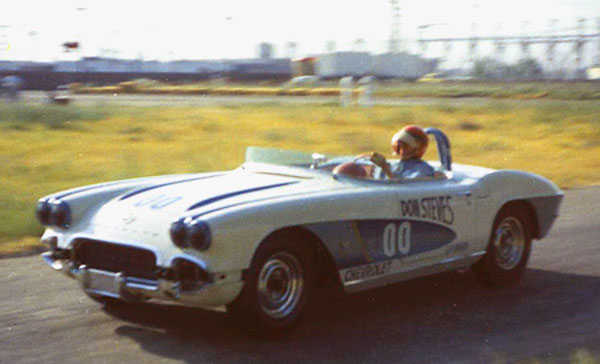 The rest of the season, MacDonald drove the Special only two more times – on May 27 at Santa Barbara and September 23 at the Reno Grand Prix. While the car showed excellent potential, the team never fully developed the car. Plus, the timing wasn’t right, as “opportunity” came knocking when Shelby began courting MacDonald to drive his new Cobra racers.
The rest of the season, MacDonald drove the Special only two more times – on May 27 at Santa Barbara and September 23 at the Reno Grand Prix. While the car showed excellent potential, the team never fully developed the car. Plus, the timing wasn’t right, as “opportunity” came knocking when Shelby began courting MacDonald to drive his new Cobra racers.
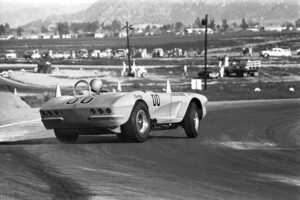 At this point, we need to hit “Still Pause” and back up a little. While Duntov indeed visited MacDonald in the Summer of ‘61, it was never documented that it was the Corvette Special that gave Zora the idea for the ’63 “Lightweight” Grand Sport. After all, Duntov was well versed on tube-framed lightweights.
At this point, we need to hit “Still Pause” and back up a little. While Duntov indeed visited MacDonald in the Summer of ‘61, it was never documented that it was the Corvette Special that gave Zora the idea for the ’63 “Lightweight” Grand Sport. After all, Duntov was well versed on tube-framed lightweights.
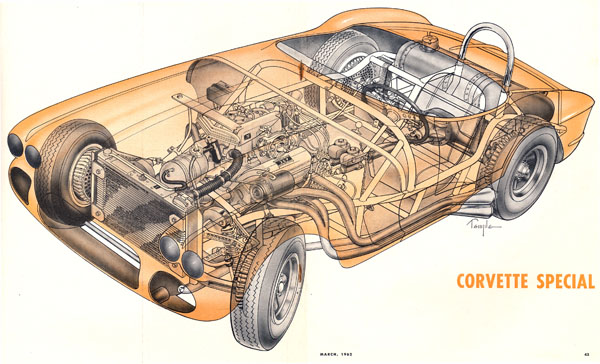 But clearly, the Corvette Special’s performance at the December ‘61 Cotati race captured the attention of Sports Car Graphic magazine as the way of the future for Corvette. The cover of the March 1962 issue says, “Complete Tech Report Cutaway And Details MacDonald Corvette Special.” Inside was a 6-page feature story with a 2-page center spread cutaway technical illustration of the car.
But clearly, the Corvette Special’s performance at the December ‘61 Cotati race captured the attention of Sports Car Graphic magazine as the way of the future for Corvette. The cover of the March 1962 issue says, “Complete Tech Report Cutaway And Details MacDonald Corvette Special.” Inside was a 6-page feature story with a 2-page center spread cutaway technical illustration of the car.
The magazine “might” have gotten Duntov’s attention because in Lowell C. Paddock’s book, “Corvette Grand Sport” on page 16 it says, “In early 1962, Zora Arkus-Duntov and an elite group of Chevrolet engineers were given the green light by Chevrolet boss Bunkie Knudsen to begin work on a lightweight Sting Ray.”
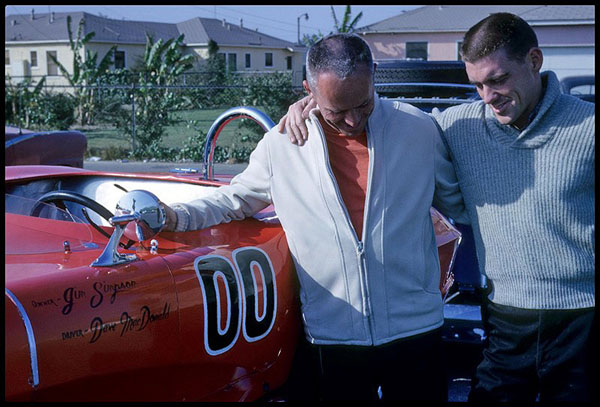 Duntov wanted to build at least 125 lightweights to qualify them as “production cars.” Zora knew from his 1957 Corvette SS experience that it would take too long to develop and mass-produce birdcage-framed cars. The quickest way to get his lightweight into production was to build a simple, strong, ladder-type tube frame with the then-new, 4-wheel independent suspension used in the upcoming ‘63 Sting Ray. Was the MacDonald ’61 Corvette Special the cause of the Grand Sport, or, would Duntov the tactician have moved to make a lightweight Sting Ray just the same? While we’ll never know for sure, the timing was awfully close.
Duntov wanted to build at least 125 lightweights to qualify them as “production cars.” Zora knew from his 1957 Corvette SS experience that it would take too long to develop and mass-produce birdcage-framed cars. The quickest way to get his lightweight into production was to build a simple, strong, ladder-type tube frame with the then-new, 4-wheel independent suspension used in the upcoming ‘63 Sting Ray. Was the MacDonald ’61 Corvette Special the cause of the Grand Sport, or, would Duntov the tactician have moved to make a lightweight Sting Ray just the same? While we’ll never know for sure, the timing was awfully close.
Even though the Special was parked, MacDonald kept on his winning ways. On August 21, 1962, Dave and Dr. Dick Thompson test-drove the new ‘63 Sting Ray for a Chevrolet promotional film. Look up “Biography of a Sports Car – Dave MacDonald & Dick Thompson Test New 1963 Sting Ray” on YouTube” to see the 7-minute video. By the end of the year, MacDonald was given an offer he couldn’t refuse.
In ‘63, MacDonald began to spread his driving wings. Dave drove Cobras for Shelby, ventured into NASCAR racing, and helped develop Shelby’s King Cobra. It was a heady time for the good-looking “good guy” from El Monte, California. Just as it is today, racing at the Indy 500 is the pinnacle of success for any race car driver. MacDonald got his Indy rookie shot driving for “The King of Speed”, Mickey Thompson.
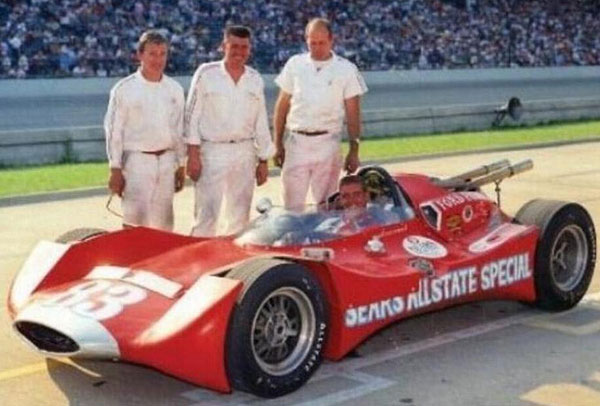 Shortly before Dave raced at Indy, he confided his career plans with his younger brother Doug. Dave had built several race cars at this point and was a respected driver and mechanic. He’d also been paying attention to Shelby’s racing business operation. Dave shared with Doug that after Indy he wanted to start his own team and build his own design race cars, with Doug as his main driver. A smart driver knows when to hang up his helmet and perhaps Dave sensed that it was time to get out of the driver’s seat. But, that was not to be.
Shortly before Dave raced at Indy, he confided his career plans with his younger brother Doug. Dave had built several race cars at this point and was a respected driver and mechanic. He’d also been paying attention to Shelby’s racing business operation. Dave shared with Doug that after Indy he wanted to start his own team and build his own design race cars, with Doug as his main driver. A smart driver knows when to hang up his helmet and perhaps Dave sensed that it was time to get out of the driver’s seat. But, that was not to be.
So what became of the ’61 Corvette Special?
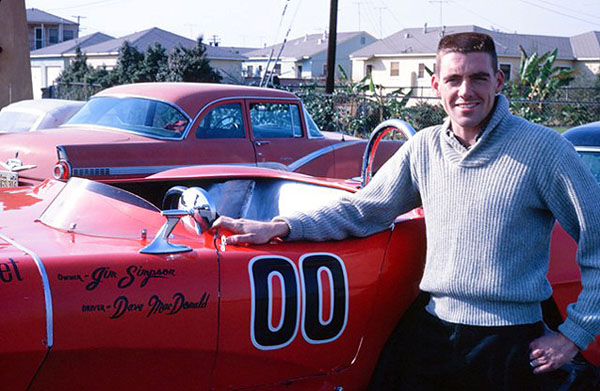 After the car was retired for the ‘62 season, Jim Simpson did what most used race car owners do – he sold the car. In late Spring of ‘62, Simpson sold the Special to a used car dealer in Hawaii, Pat Mathis, who raced the car a few times in Hawaii but it seemed that the 1,750-pound car was more than a match for his skills. Later that year the car was sent back to the mainland where MacDonald raced for the last time on September 23, 1962, at Reno. Here’s where the story fades into myth.
After the car was retired for the ‘62 season, Jim Simpson did what most used race car owners do – he sold the car. In late Spring of ‘62, Simpson sold the Special to a used car dealer in Hawaii, Pat Mathis, who raced the car a few times in Hawaii but it seemed that the 1,750-pound car was more than a match for his skills. Later that year the car was sent back to the mainland where MacDonald raced for the last time on September 23, 1962, at Reno. Here’s where the story fades into myth.
There seem to be two possible ends to the story.
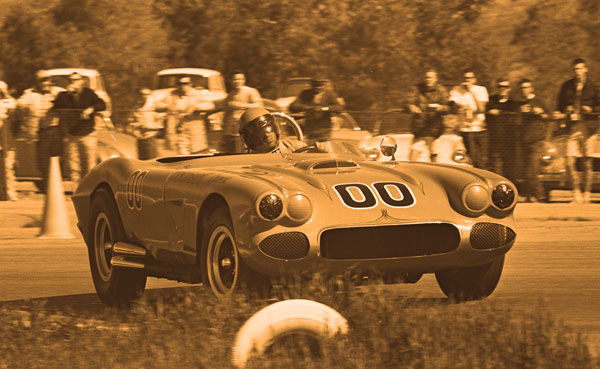 First is that the car was sold to a man in the northwest that cut up the car to make it into a drag racer. If this was the case, the MacDonald/Simpson ’61 Corvette Special could qualify as a prehistoric altered-wheelbase A/FX race car or even a “Funny Car”. Check the side-view illustration, the driver’s seat is almost on top of the rear differential. The car definitely has an “altered-wheelbase” look.
First is that the car was sold to a man in the northwest that cut up the car to make it into a drag racer. If this was the case, the MacDonald/Simpson ’61 Corvette Special could qualify as a prehistoric altered-wheelbase A/FX race car or even a “Funny Car”. Check the side-view illustration, the driver’s seat is almost on top of the rear differential. The car definitely has an “altered-wheelbase” look.
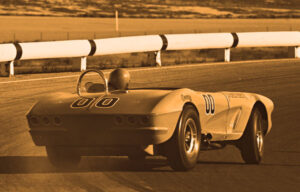 The second is based on the rumor that the car was left outside at an auto junkyard in Hawaii, close to Pearl Harbor, and hasn’t been seen since 1969. If the car was left out in the strong Hawaiian elements, Its Balchowsky chassis and running gear rusted together, its bright orange paint faded away, and its fiberglass dried out and easily broken into flakes.
The second is based on the rumor that the car was left outside at an auto junkyard in Hawaii, close to Pearl Harbor, and hasn’t been seen since 1969. If the car was left out in the strong Hawaiian elements, Its Balchowsky chassis and running gear rusted together, its bright orange paint faded away, and its fiberglass dried out and easily broken into flakes.
Either outcome is rather unfitting for a Corvette race car, let alone a car with the real possibility that the MacDonald/Simpson ’61 Corvette Special may well have been the inspiration for the legendary 1963 Grand Sport Corvette!
As we will never really know what happened to the car, this is a story that can only fit into the file folder titled, “Could Have Been”. While restored old race cars are wonderful, the fact is that they all can’t be saved. – Scott


